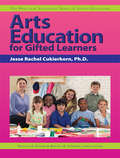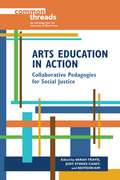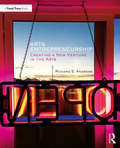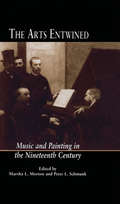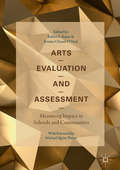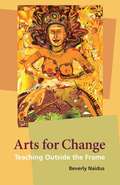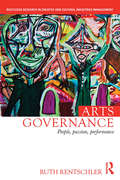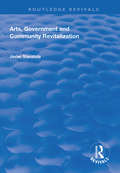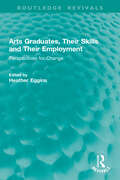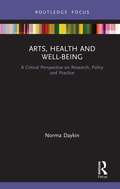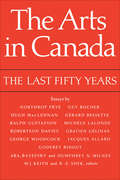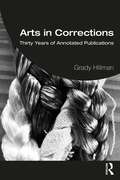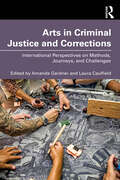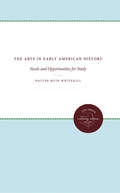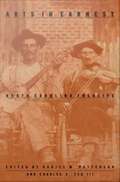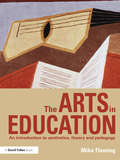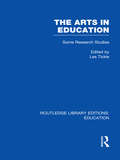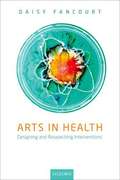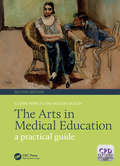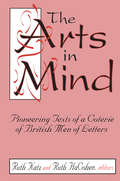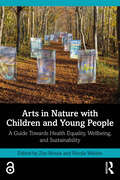- Table View
- List View
Arts Education for Gifted Learners
by Jesse Rachel CukierkornArts Education for Gifted Learners provides information for teachers and parents interested in supporting an artistically talented child. It reveals the characteristics of artistically talented students, describes program options, and shares an approach for supporting the affective needs of these students. This is one of the books in Prufrock Press' popular Practical Strategies Series in Gifted Education. This series offers a unique collection of tightly focused books that provide a concise, practical introduction to important topics concerning the education of gifted children. The guides offer a perfect beginner's introduction to key information about gifted and talented education.
Arts Education in Action: Collaborative Pedagogies for Social Justice (Common Threads)
by Travis, Sarah; Stokes-Casey, Jody; Kim, SeoyeonArts educators have adopted social justice themes as part of a larger vision of transforming society. Social justice arts education confronts oppression and inequality arising from factors related to race, ethnicity, nationality, religion, class, ability, gender, and sexuality. This edition of Common Threads investigates the intersection of social justice work with education in the visual arts, music, theatre, dance, and literature. Weaving together resources from a range of University of Illinois Press journals, the editors offer articles on the scholarly inquiry, theory, and practice of social justice arts education. Selections from the past three decades reflect the synergy of the diverse scholars, educators, and artists actively engaged in such projects. Together, the contributors bring awareness to the importance of critically reflective and inclusive pedagogy in arts educational contexts. They also provide pedagogical theory and practical tools for building a social justice orientation through the arts. Contributors: Joni Boyd Acuff, Seema Bahl, Elizabeth Delacruz, Elizabeth Garber, Elizabeth Gould, Kirstin Hotelling, Tuulikki Laes, Monica Prendergast, Elizabeth Saccá, Alexandra Schulteis, Amritjit Singh, and Stephanie Springgay
Art's Emotions: Ethics, Expression and Aesthetic Experience
by Damien FreemanDespite the very obvious differences between looking at Manet’s Woman with a Parrot and listening to Elgar’s Cello Concerto, both experiences provoke similar questions in the thoughtful aesthete: why does the painting seem to express reverie and the music, nostalgia? How do we experience the reverie and nostalgia in such works of art? Why do we find these experiences rewarding in similar ways? As our awareness of emotion in art, and our engagement with art’s emotions, can make such a special contribution to our life, it is timely for a philosopher to seek to account for the nature and significance of the experience of art’s emotions. Damien Freeman develops a new theory of emotion that is suitable for resolving key questions in aesthetics. He then reviews and evaluates three existing approaches to artistic expression, and proposes a new approach to the emotional experience of art that draws on the strengths of the existing approaches. Finally, he seeks to establish the ethical significance of this emotional experience of art for human flourishing. Freeman challenges the reader not only to consider how art engages with emotion, but how we should connect up our answers to questions concerning the nature and value of the experiences offered by works of art.
Arts, Entertainment and Tourism
by Howard Hughes'Arts, Entertainment and Tourism' is a pioneering text that, by focusing on the consumer, investigates the relationship between these 3 industries and how this relationship can be developed to its best competitive advantage. Issue-led, this text draws on appropriate disciplines rather than using one single approach, to examine issues in arts and entertainment within the framework of cultural tourism.Written to meet the needs of students studying on management courses in the arts, tourism and leisure, 'Arts, Entertainment and Tourism':* Describes the general arts and tourism background* Identifies a framework for analysis that acknowledges differing levels of interest in the arts and entertainment* Discusses the arts and entertainment that feature (past and present) in tourism * Examines the reasons why the arts, entertainment and tourism have an interest in each other and how they go about developing the relationship* Examines the relationship: are there tourists in audiences and do the arts and entertainment attract tourists to a destination?* Evaluates the wider effects (good and bad) on both the arts and tourism* Discusses the direction of future developments by arts and tourism organizations and for future research
Arts & Entertainments: A Novel
by Christopher BehaA drama teacher finds unlikely celebrity thanks to a nearly forgotten sex tape in this ingenious . . . entertaining and thought provoking” novel (Booklist).At thirty-three, Eddie Hartley has given up his dream of becoming an actor for the reality of life as a drama teacher at a boys’ prep school. But when Eddie and his wife, Susan, discover they cannot have children, it is one disappointment too many.Weighted down with debt, his wife’s mounting unhappiness, and his own deepening sense of failure, Eddie is confronted with an alluring solution when an old friend-turned-web-impresario suggests Eddie sell a sex tape he made with an ex-girlfriend, now a wildly popular television star. Overcoming his initial moral qualms, Eddie figures that in an era when any publicity is good publicity, the tape won’t cause any harm—a decision that will propel him straight into the glaring spotlight he once thought he craved.A hilariously biting and incisive take-down of our culture’s monstrous obsession with fame, Arts & Entertainments is also a poignant and humane portrait of a young man’s belated coming-of-age, the complications of love, and the surprising ways in which the most meaningful lives often turn out to be the ones we least expected to lead.
Arts Entrepreneurship: Creating a New Venture in the Arts
by Richard AndrewsArts Entrepreneurship: Creating a New Venture in the Arts provides the essential tools, techniques, and concepts needed to invent, launch, and sustain a business in the creative sector. Building on the reader’s artistic talents and interests, the book provides a practical, action-oriented introduction to the business of art, focusing on product design, organizational planning and assessment, customer identification and marketing, fundraising, legal issues, money management, cultural policy, and career development. It also offers examples, exercises, and references that guide entrepreneurs through the key stages of concept creation, business development, and growth. Special attention is paid to topics such as cultural ventures seeking social impact, the emergence of creative placemaking, the opportunities afforded by novel corporate forms, and the role of contemporary technologies in marketing, fundraising, and operations. A hands-on guide to entrepreneurial success, this book is a valuable resource for students of Arts Entrepreneurship programs, courses, and workshops, as well as for early-stage business founders in the creative sector looking for guidance on how to create and sustain their own successful venture.
The Arts Entwined: Music and Painting in the Nineteenth Century (Critical and Cultural Musicology)
by Marsha Morton Peter L. SchmunkThis collection of essays by musicologists and art historians explores the reciprocal influences between music and painting during the nineteenth century, a critical period of gestation when instrumental music was identified as the paradigmatic expressive art and theoretically aligned with painting in the formulation ut pictura musica (as with music, so with painting). Under music's influence, painting approached the threshold of abstraction; concurrently many composers cultivated pictorial effects in their music. Individual essays address such themes as visualization in music, the literary vs. pictorial basis of the symphonic poem, musical pictorialism in painting and lithography, and the influence of Wagner on the visual arts. In these and other ways, both composers and painters actively participated in interarts discourses in seeking to redefine the very identity and aims of their art. Also includes 17 musical examples.
Arts Evaluation and Assessment: Measuring Impact in Schools and Communities
by Rekha S. Rajan Ivonne Chand O’nealThis book addresses the challenges faced by arts organizations, schools, and community-based settings when designing program evaluations and measuring artistic engagement and experience. With contributions from leaders in the field, this volume is an exemplary collection of complete program evaluations that assess music, theater, dance, multimedia, and the visual arts in a variety of contexts.
Arts for Change: Teaching Outside the Frame
by Beverly NaidusBeverly Naidus shares her passion and strategies for teaching socially engaged art, offering, as well, a short history of the field and the candid views of more than thirty colleagues. A provocative, personal look at the motivations and challenges of teaching socially engaged arts, Arts for Change overturns conventional arts pedagogy with an activist's passion for creating art that matters.How can polarized groups work together to solve social and environmental problems? How can art be used to raise consciousness? Using candid examination of her own university teaching career as well as broader social and historical perspectives, Beverly Naidus answers these questions, guiding the reader through a progression of steps to help students observe the world around them and craft artistic responses to what they see. Interviews with over 30 arts education colleagues provide additional strategies for successfully engaging students in what, to them, is most meaningful.
Arts Governance: People, Passion, Performance (Routledge Research in Creative and Cultural Industries Management)
by Ruth RentschlerSince the crisis in governance which led to a shortage of capable board members, recent years have seen the emergence of the enterprising arts organisation – a development which has led to the need for new types of board members who have a greater understanding of 'mission, money and merit' within a cultural construct. This innovative book explores the world of the arts board member from the unique perspective of the cultural and creative industries. Using a wide range of research techniques including interviews with board members and stakeholders, board observations and case studies this book provides a rich and deep analysis from inside the boardroom. It provides in-depth insight into the changing pressures on arts boards after the financial crisis, and focuses uniquely on the role of passion on arts boards. Part of the Routledge Research in Creative and Cultural Industries Management series, written specifically for people seeking to develop their careers in cultural and creative management, this book is also for people working in and with arts organisations, in government and non-profit arts organisations. It will also be of interest to academics and researchers working in the wider corporate governance field.
Arts, Government and Community Revitalization (Routledge Revivals)
by Javier StanziolaFirst published in 1999, this book goes beyond the standard economic tools used to evaluate the effectiveness of arts in redevelopment processes. It assumes that the sectors involved in the process of arts-led community revitalization (artists, non-profit organizations, government and for-profit firms) act upon the economic structure and initiate a resurgence path. This assumption allows us to study the political and economic interaction among these sectors, understand their incentives and define and explore their boundaries. This book explores the 1) cultural and regeneration reasons for revitalization; 2) sources of funds; 3) political interaction; 4) definition and estimation of output; 5) evaluation of output; 6) estimation of coefficients and multipliers effects obtained from input-output tables.
Arts Graduates, Their Skills and Their Employment: Perspectives for Change (Routledge Revivals)
by Heather EgginsOriginally published in 1992, this book was the first to gather together the view of industrialists, teachers and researchers. It focusses on the skills dimension of arts graduates which carry significant implication for all undergraduate programmes. It examines how the humanities and the world of work interact and how the relationship might be shaped in the future as the United Kingdom moved rapidly to a system of mass higher education. This book will be of use to all those responsible for enabling the new graduate of whatever subject to develop their skills and marketability to the full.
Arts, Health and Well-Being: A Critical Perspective on Research, Policy and Practice
by Norma DaykinThis important book develops a critical understanding of the bridging of arts and health domains, drawing on models and perspectives from social sciences to develop the case for arts and health as a social movement. This interdisciplinary perspective offers a new research agenda that can help to inform future developments and sustainability in arts, health and well-being. Daykin begins with an overview of the current evidence base and a review of current challenges for research, policy and practice. Later chapters explore the international field of health and the arts; arts, with well-being as a social movement; and boundary work and the role of boundary objects in the field. The book also includes sections summarising research findings and evidence in arts and health research and examples from specific research projects conducted by the author, chosen to highlight particularly widespread challenges across many arts, health and well-being contexts. Arts, Health and Well-Being: A Critical Perspective on Research, Policy and Practice is valuable reading for students in sociology, psychology, social work, nursing, psychiatry, creative and performing arts, public health and policymakers and practitioners in these fields.
Arts & Ideas (7th edition)
by William FlemingIntended for courses in Western Humanities, this book chronologically explores the major styles as they appear in painting, sculpture, architecture, literature, music, and philosophy from antiquity to present using lively anecdotes.
The Arts in Canada: The Last Fifty Years
by William Keith Ben-Z. ShekIn this volume a baker's dozen of creative Canadians make personal responses to the state of the arts in Canada: Northrop Frye and Guy Rocher write on general cultural trends; Hugh MacLennan and Gérard Bessette on fiction; Ralph Gustafson and Michèle Lalonde on poetry; Robertson Davies and Gratien Gélinas on drama; George Woodcock and Jacques Allard on non-fiction prose; Godfrey Ridout on music, and Aba Bayefsky and Humphrey N. Milnes on art. The essays were written to mark the fiftieth anniversary of the University of Toronto Quarterly. The contributors were invited to discuss the changes, problems, challenges, and achievements in the arts in the last fifty years. Since all the authors had personal experience of at least a large section of the period surveyed, the editors welcomed personal reminiscence as well as description and assessment. The result is a varied group of essays in each of which the character of the individual artist is clearly evident; together, they provide a complex, many-faceted, lively, and living discussion of the cultural development of Canada. This anniversary collection of essays is a valuable and provocative source for courses in Canadian studies and for anyone interested in the development of the arts and humanities in Canada.
Arts in Corrections: Thirty Years of Annotated Publications
by Grady HillmanIn Arts in Corrections, the author—a poet, translator and teacher—takes readers on a chronological journey through an annotated selection of 24 of his own publications from 1981 to 2014 which recount his experiences teaching, consulting and documenting US arts programs in prisons, jails and juvenile facilities. Anyone interested in corrections and arts-in-corrections will be drawn in by the poetic sensibility Hillman brings to his writing. Readers will gain a historical and personal perspective not only into correctional arts programming in the US over the last 40 years, but also the institutional transformations in policy, culture, populations, economics, and the criminological mission expansion into other institutional settings like K-12 education. Original essays, articles, monographs and poems are interspersed with recent annotations to deliver not only a top-down view of the correctional system but also the author’s personal journey of "discouragement and hope" from work conducted in approximately 200 adult and juvenile facilities in 30 states and six countries. This comprehensive book is essential reading for a broad cross-section of international readers interested in and involved in the arts-in-corrections field. With two million individuals behind bars in the US at any given time, the profile of arts programs in prisons and jails is rising and interest in criminal-justice matters more generally is increasing. This includes not only arts-in-corrections professionals, policy makers, students, researchers, advocates and academics, but professionals in multiple other fields as well as the general public.
Arts in Criminal Justice and Corrections: International Perspectives on Methods, Journeys, and Challenges
by Amanda Gardner and Laura CaulfieldOffering a lively, international, and interdisciplinary introduction to research on arts programmes in prisons, Arts in Criminal Justice and Corrections is the first volume to bring together leading figures from the USA, the UK, Australia, New Zealand, and Belgium to explore key methodological approaches and issues through the lens of the researchers themselves.Beginning with the original pioneers of research into the arts in corrections in the USA in the 1980s, this book highlights the role of researchers in evidencing impact and influencing policy. Contributors include those who were themselves once incarcerated and those who have transitioned from practitioner to criminologist. Chapters lay the groundwork for discussion on how an important avenue for rehabilitation and re-entry can be developed, providing a call to action for more research into a field which holds promise for building a more just, equitable, and inclusive society.This book is essential reading for criminologists engaged in prisons, corrections, and desistance research, as well as researchers and practitioners in the arts and rehabilitation.
The Arts in Early American History: Needs and Opportunities for Study (Published by the Omohundro Institute of Early American History and Culture and the University of North Carolina Press)
by Walter Muir WhitehillThis summary essay and the heavily annotated bibliography covering the period from the first colonization to 1826 are primarily intended to aid the scholar and student by suggesting areas of further study and ways of expanding the conventional interpretations of early American history.Originally published in 1935. <br> A UNC Press Enduring Edition -- UNC Press Enduring Editions use the latest in digital technology to make available again books from our distinguished backlist that were previously out of print. These editions are published unaltered from the original, and are presented in affordable paperback formats, bringing readers both historical and cultural value.
Arts in Earnest: North Carolina Folklife
by Daniel W. Patterson Charles G. Zug IIIArts in Earnest explores the unique folklife of North Carolina from ruddy ducks to pranks in the mill. Traversing from Murphy to Manteo, these fifteen essays demonstrate the importance of North Carolina's continually changing folklife. From decoy carving along the coast, to the music of tobacco chants and the blues of the Piedmont, to the Jack tales of the mountains, Arts in Earnest reflects the story of a people negotiating their rapidly changing social and economic environment. Personal interviews are an important element in the book. Laura Lee, an elderly black woman from Chatham County, describes the quilts she made from funeral flower ribbons; witnesses and friends each remember varying details of the Duke University football player who single-handedly vanquished a gang of would-be muggers; Clyde Jones leads a safari through his backyard, which is filled with animals made of wood and cement that represent nontraditional folk art; the songs and sermon of a Primitive Baptist service flow together as one--"it tills you up all over"; Durham bluesman Willie Trice, one of a handful of Durham musicians who recorded in the 1930s and early 1940s, remembers when the active tobacco warehouses offered ready audiences--"They'd tip us a heap of change to play some music"; and Goldsboro tobacco auctioneer H. L. "Speed" Riggs chants 460 words per minute, five to six times faster than a normal conversational rate.
The Arts in Education: An introduction to aesthetics, theory and pedagogy
by Mike FlemingDo the arts improve academic achievement? What does it mean to ‘teach’ art? What should the balance of classic and pop be in the music curriculum? Should we encourage young children on the stage? How do we judge whether what a child produces is good? How do we justify the arts in the curriculum? What should be the balance between form and content when teaching art? The arts in education inspire considerable commitment and passion. However, this is not always matched by clarity of understanding. In this book Mike Fleming introduces the reader to key theoretical questions associated with arts education and clearly explains how these are related to practice. It offers an authoritative account of how ideas relevant to education are addressed by key authors in aesthetics, art theory and cultural studies. Covering all aspects of arts education, the book considers: definitions and theories of art influences on teaching the arts researching the arts teaching and learning creativity assessment. Throughout the book there are examples of practice to illustrate key ideas and a discussion of useful background texts with a summary of content and arguments for further exploration. Written by a leading authority in the field, it is essential reading for students on Arts PGCE and M Level courses, teachers of the arts and policy developers that require more understanding and insight into their practice.
The Arts in Education: Some Research Studies (Routledge Library Editions: Education)
by Les TickleThe arts in education are currently the subject of considerable controversy. Some people argue that fostering creativity in schools is important; that the arts can provide a substantial contribution to the development of the capacity for creative thought and action; and that therefore the arts should be well represented at all levels of the school curriculum. Some argue that the education system, in fact, leaves pupils incomplete, stultified and uncreative. Others argue that it is the processes of teaching and learning in the arts which are at fault because they are too passive. This book surveys the different sides of the debate and goes on to report on original research which examines just how the arts are taught in schools. It thereby makes a considerable contribution to the debate which has hitherto been incomplete due to a lack of evidence.
Arts in Health: Designing and Researching Interventions
by Daisy FancourtArts in Health: Designing and Researching Interventions provides a complete overview of how to go about undertaking research and practice in the field of arts in health. It starts by exploring the context for arts in health interventions, including the history of the use of arts in health and the theoretical and political developments that have laid the foundations for its flourishing. It also considers what 'arts in health' encompasses and the range of disciplines involved. Part II examines how to design an arts in health intervention, develop partnerships and find funding and considers the sensitivities around working in healthcare. Part III considers the value of research for the field of arts in health and how to design and undertake a research project. Part IV provides a fact file of arts in health research and practice, showing how the arts can be applied and the benefits they can bring across a range of medical disciplines. The book will be valuable for researchers, practitioners, healthcare professionals and those interested in learning more about the field.
The Arts in Medical Education: A Practical Guide, Second Edition
by Elaine Powley Roger HigsonThe first edition of The Arts in Medical Education outlined the principles and methods for using arts resources in teaching aspects of the medical curriculum. The second edition has been expanded with new chapters, which enliven and enhance the teaching of some of the more challenging areas of medical practice. The book includes many colour illustrations, photographs, poems and literary extracts. It is invaluable to healthcare educators and medical professionals with teaching responsibilities, offering information, structure and inspiration. 'There is considerable art in the practice of medicine. This book represents a practical tool to stimulate educators and learners to consider new approaches to medical education that reflect changing societal needs and practice patterns by introducing the visual and literary arts to medical education; to embrace the art of medicine. Medical schools around the world are exploring the influence of the visual arts on physician practice and understanding the nature of healing as well as suffering. We hope you will find this book an important tool in your exploration of the power and influence of the arts in medicine.'ere is considerable art in the practice of medicine. This book represents a practical tool to stimulate educators and learners to consider new approaches to medical education that reflect changingsocietal needs and practice patterns by introducing the visual and literary arts to medical education; to embrace the art of medicine. Medical schools around the world are exploring the influence of the visual arts on physician practice and understanding the nature of healing as well as suffering. We hope you will find this book an important tool in your exploration of the power and influence of the arts in medicine.'
The Arts in Mind: Pioneering Texts of a Coterie of British Men of Letters
by Ruth Katz Ruth HaCohen editorsAmajor shift in critical attitudes toward the arts took place in the eighteenth century. The fine arts were now looked upon as a group, divorced from the sciences and governed by their own rules. The century abounded with treatises that sought to establish the overriding principles that differentiate art from other walks of life as well as the principles that differentiate them from each other. This burst of scholarly activity resulted in the incorporation of aesthetics among the classic branches of philosophy, heralding the cognitive turn in epistemology. Among the writings that initiated this turn, none were more important than the British contribution. The Arts in Mind brings together an annotated selection of these key texts.A companion volume to the editors' Tuning the Mind, which analyzed this major shift in world view and its historical context, The Arts in Mind is the first representative sampling of what constitutes an important school of British thought. The texts are neither obscure nor forgotten, although most histories of eighteenth-century thought treat them in a partial or incomplete way. Here they are made available complete or through representative extracts together with an editor's introduction to each selection providing essential biographical and intellectual background. The treatises included are representative of the changed climate of opinion which entailed new issues such as those of perception, symbolic function, and the role of history and culture in shaping the world.>
Arts in Nature with Children and Young People: A Guide Towards Health Equality, Wellbeing, and Sustainability
by Zoe Moula Nicola WalsheThis novel text brings together research and practice on the intersection between arts and nature and their impact on children and young people’s wellbeing, health equality and sustainability.Existing literature focuses on either the impact of the arts or the impact of being in/with nature on children’s and young people’s wellbeing. However, the intersection between the two – arts and nature – and their combined effect on wellbeing has received limited attention. Through five research-based and seven practice-based chapters, this book draws upon arts-in-nature practices that incorporate visual arts, music, movement, drama and poetry, in a range of natural environments, such as forests, beaches, greenhouses, parks, community areas and school playgrounds.Arts in Nature with Children and Young People will appeal to anyone working with children and young people, including mental health and healthcare professionals, teachers, researchers, artists, and arts therapists. It is also an accessible guide for parents and families looking for inspiration and ideas for creative and outdoor activities.
